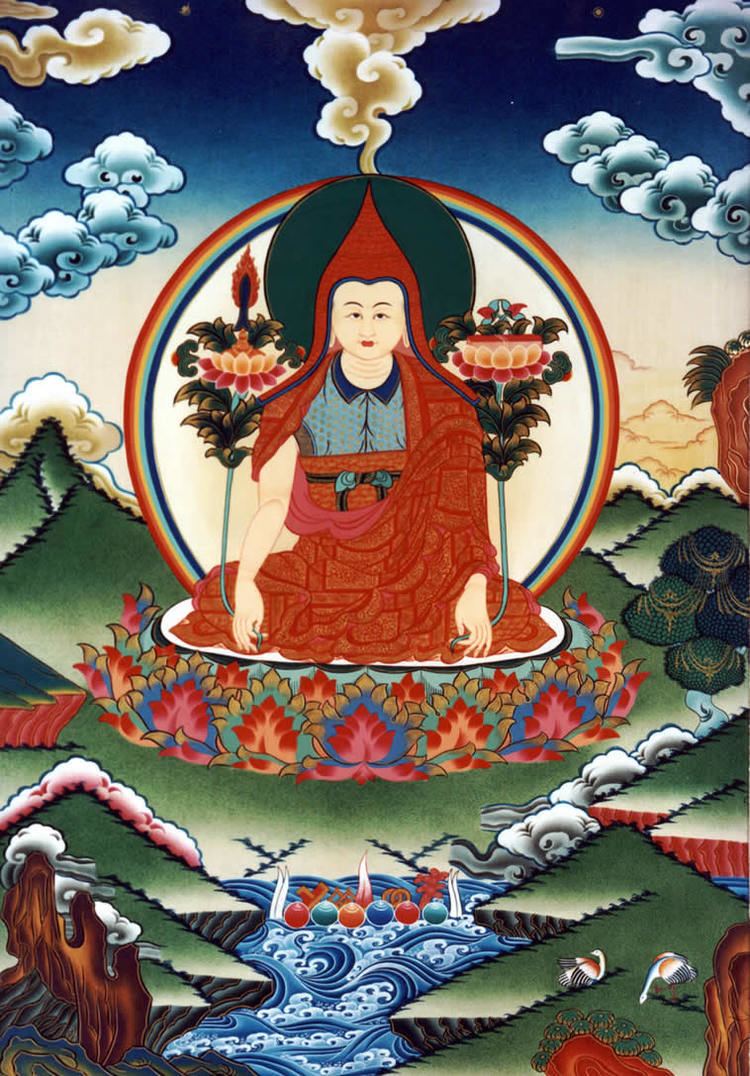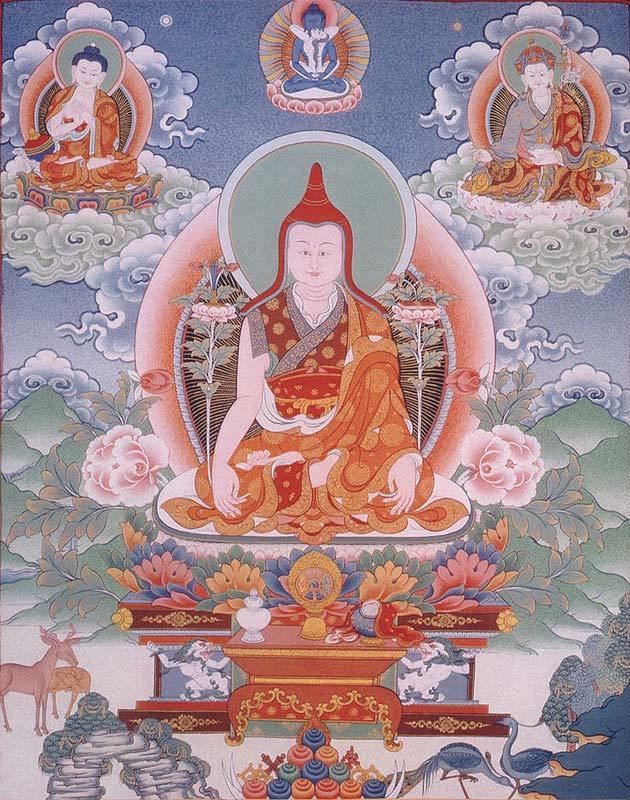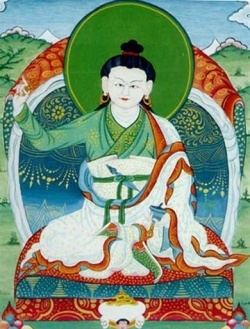Name Longchenpa Longchenpa Tibetan ཀློང་ཆེན་རབ་འབྱམས་པ Lhasa IPA [loŋtɕʰepa] | Traditional Chinese 隆欽然絳巴 Died 1363 | |
 | ||
Wylie klong chen rab 'byams pa THDL Longchen Rapchampa (Longchenpa) Tibetan Pinyin People also search for Namkhai Norbu, Thondup Tulku., Bdud-ʼjoms ʼJigs-bral-ye-ses-rdo-rje, Alexander Berzin Books Natural Perfection: Longche, The Precious Treasury, You are the eyes of the world, The practice of Dzogchen, Kindly Bent to Ease Us: Wonderment | ||
Longchenpa six perfections
Longchen Rabjampa, Drimé Özer (Wylie: klong chen rab 'byams pa dri med 'od zer), commonly abbreviated to Longchenpa (1308–1364), was a major teacher in the Nyingma school of Tibetan Buddhism. Along with Sakya Pandita and Je Tsongkhapa, he is commonly recognized as one of the three main manifestations of Manjushri to have taught in Central Tibet. His major work is the Seven Treasuries, which encapsulates the previous six hundred years of Buddhist thought in Tibet. Longchenpa was a critical link in the exoteric and esoteric transmission of the Dzogchen teachings. He was abbot of Samye, one of Tibet's most important monasteries and the first Buddhist monastery established in the Himalaya, but spent most of his life travelling or in retreat.
Contents
- Longchenpa six perfections
- Rolmo interview the life of longchenpa jampa mackenzie stewart
- Biography
- Influence
- Works
- Selected English translations
- Name and titles
- References

Rolmo interview the life of longchenpa jampa mackenzie stewart
Biography

Longchen Rabjampa was born at Gra-phu stod-gron in g.Yo-ru in Eastern dBus in Central Tibet on the eighth day of the second lunar month of the Earth-Male-Ape year (i.e., Friday 1 March 1308, which was at the beginning of that Tibetan calendrical year). The date of Longchen Rabjampa's parinirvāṇa (his relinquishing of the appearance of his physical form manifest to others—or, in common parlance, his "death" or "demise") was the eighteenth day of the twelfth lunar month of the Water-Female-Hare year (i.e., Wednesday 24 January 1364, which was at the end of that Tibetan calendrical year; he did not die in 1363, as has sometimes been maintained) at O-rgyan-rdzong in Gangs-ri thod-kar, Tibet.

Longchenpa is regarded as an indirect incarnation of the princess Pema Sal. He was born to the master Tenpasung, an adept at both the sciences and the practice of mantra, and Dromza Sonamgyen, who was descended from the family of Dromton Gyelwie Jungne. Legend states that at age five, Longchenpa could read and write and by age seven his father began instructing him in Nyingma tantras. Longchenpa was first ordained at the age of twelve and studied extensively with the Third Karmapa, Rangjung Dorje. He received not only the Nyingma transmissions as passed down in his family, but also studied with many of the great teachers of his day without regard to sect. He thus received the combined Kadam and Sakya teachings of the Sutrayana through his main Sakya teacher, Palden Lama Dampa Sonam Gyaltsen, in addition to the corpus of both old and new translation tantras. At the age of nineteen, Longchenpa entered the famous shedra (monastic college) Sangpu Neutok (Wylie: gSang-phu Ne'u-thog), where he acquired great scholarly wisdom. He later chose to practice in the solitude of the mountains, after becoming disgusted by the unpleasant behavior of certain scholars.
When he was in his late twenties two events occurred that were to be of decisive importance in his intellectual and spiritual development. One was a vision of Guru Padmasambhava and his consort Yeshe Tsogyal. The other happened in his twenty-ninth year, his meeting with the great mystic Rigdzin Kumaradza (alt. Kumaraja) from whom he received the Dzogchen empowerment and teachings in the mountains, the uplands of Yartökyam at Samye where he was traveling from valley to valley with his students under the most difficult of circumstances. Dudjom Rinpoche (1904–1987) et al. (1991: p. 579) held that just prior to the arrival of Longchenpa, Kumaraja related to his disciples:
"Last night I dreamt that a wonderful bird, which announced itself to be a divine bird, came with a large flock in attendance, and carried away my books in all directions. Therefore, someone will come to hold my lineage."

Kumaraja accepted no outer tribute from Longchenpa for the teachings he received as Kumararaja through his supernormal cognitive powers discerned that Longchenpa was blameless and had offered his tribute internally.

Together with Rangjung Dorje, Longchenpa accompanied Kumaraja and his disciples for two years, during which time he received all of Rigdzin Kumaradza's transmissions. Through the efforts of these three, the diverse streams of the "Innermost Essence" (nying thig) teachings of Dzogchen were brought together and codified into one of the common grounds between the Nyingma and Karma Kagyud traditions.

After several years in retreat, Longchenpa attracted more and more students, even though he had spent nearly all of his life in mountain caves. During a stay in Bhutan (Tib., Mon), Longchenpa fathered a daughter and a son, of which the latter, Trugpa Odzer (b. 1356), also became a holder of the Nyingtig lineage. A detailed account of the life and teachings of Longchenpa is found in Buddha Mind by Tulku Thondup Rinpoche and in A Marvelous Garland of Rare Gems by Nyoshul Khenpo.

Pema Lingpa the famous terton (finder of sacred texts) of Bhutan is regarded as the immediate reincarnation of Longchenpa.
In the Nyingma lineage, Longchenpa, Rongzom, and Mipham are known as "the Three Omniscient Ones".
Influence
David Germano, in his doctoral thesis on the Tsigdön Dzö (tshigs don mdzod) (one of the Seven Treasuries), frames the brilliance of Longchenpa within the wider discourse of the Dzogchen tradition (found in the Bonpo Zhangzhung and Indo-Tibetan traditions of Buddhism):
"Although at least five hundred years (800 CE - 1300 CE) of thought, contemplation and composition in this tradition (which may not have been a clearly self-conscious tradition in the beginning) preceded him such that all the major themes, structures, and terminology were in place prior to his birth (above all in the canonical Seventeen Tantras of the Great Perfection (rgyud bcu bdun)), it was Longchenpa (1308-1363) [sic] who systematically refined the terminology used by the tradition with a series of subtle yet clear distinctions; brilliantly revealed its relationships with mainstream exoteric Buddhist thought; clarified its internal structure; created from it masterpieces of poetic philosophy remarkable for their aesthetic beauty, philosophical rigor, and overall clarity; and overall pinpointed the inner quintessence of the tradition with writings that not only systematized every major topic, but also creatively explained each to render crystal clear the unprecedented revolution in the content, form, and structure of "philosophical" thought in Indo-Tibetan Buddhism that the Great Perfection teachings entail."
Works
Longchenpa is widely considered the single most important writer on the Dzogchen teachings. He is credited with more than 250 works, both as author and compiler, among which are the famous Seven Treasuries (mdzod bdun), the Trilogy of Natural Freedom (rang grol skor gsum), the Trilogy of Natural Ease (ngal gso skor gsum), his Trilogy of Dispelling Darkness, and his compilation - plus commentaries - of the Nyingtig Yabshi. He is also a commentator of the Kunyed Gyalpo Tantra (Tib., kun byed rgyal po'i rgyud; "The King Who Creates Everything", Skt. kulayarāja, "the King of the Dwelling Place [of Ultimate Bodhicitta]), a text belonging to the Mind Class (Tib., sems sde) of the Ati Yoga Inner Tantras. As scholar Jacob Dalton summarizes,
His foremost writings were gathered into several collections: The Mdzod bdun (Seven Treasuries) are his most famous works, presenting the whole of Buddhist thought from a snying thig viewpoint; the Ngal gso skor gsum (Resting at Ease Trilogy) and the Rang grol skor gsum (Natural Freedom Trilogy) provide in-depth introductions to Rdzogs chen; the Mun sel skor gsum (Dispelling the Darkness Trilogy) are three commentaries on the Guhyagarbha Tantra; and the Snying thig ya bzhi (Seminal Quintessence in Four Parts) is a redaction of his three snying thig commentaries together with their predecessors, the Vima snying thig and the Mkha' 'gro snying thig.
Longchenpa combined the teachings of the Vima Nyingtig lineage with those of the Khandro Nyingtig, thus preparing the ground for the fully unified system of teachings that became known as the Longchen Nyingthig (by Jigme Lingpa).
Selected English translations
A (Seven Treasuries): 1.
2.
3.
4.
6.
7.
B (Trilogy of Natural Ease)
C (Trilogy of Natural Freedom)
D (Trilogy of Dispelling Darkness)
E (others)
Name and titles
Apart from Longchenpa's names given below, he is sometimes referred to by the honorary title "Second Buddha" (Tib. rgyal ba gnyis), a term usually reserved for Guru Padmasambhava and indicative of the high regard in which he and his teachings are held. Like the Third Karmapa Rangjung Dorje, Rongzompa and Jigme Lingpa, he carried the title "Kunkhyen" (Tibetan; "All-Knowing").
Various forms and spellings of Longchenpa's full name(s), in which 'Longchen' means "great expanse", "vast space", "great vortex", and 'Rab 'byams' "cosmic", "vast", "extensive", "infinite".
